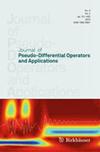三维双极可压缩纳维-斯托克斯-泊松系统中的质量集中现象
IF 1.3
3区 数学
Q2 MATHEMATICS
Journal of Pseudo-Differential Operators and Applications
Pub Date : 2024-02-10
DOI:10.1007/s11868-023-00582-y
引用次数: 0
摘要
摘要 本文研究了三维双极可压缩纳维-斯托克斯-泊松系统的炸毁机制。结果表明,只要平稳解在有限时间内出现奇点,即使初始密度包含真空态,模型的质量也会集中在某些空间点上。本文章由计算机程序翻译,如有差异,请以英文原文为准。
Mass concentration phenomenon in the 3D bipolar compressible Navier–Stokes–Poisson system
Abstract
In this paper, we investigate the blow-up mechanism to the bipolar compressible Navier–Stokes–Poisson system in three dimensions. It is essentially shown that the mass of the model will concentrate in some spatial points, even if the initial density contains vacuum states, provided that the smooth solution develops singularity in finite time.
求助全文
通过发布文献求助,成功后即可免费获取论文全文。
去求助
来源期刊

Journal of Pseudo-Differential Operators and Applications
MATHEMATICS, APPLIED-MATHEMATICS
CiteScore
2.20
自引率
9.10%
发文量
59
期刊介绍:
The Journal of Pseudo-Differential Operators and Applications is a forum for high quality papers in the mathematics, applications and numerical analysis of pseudo-differential operators. Pseudo-differential operators are understood in a very broad sense embracing but not limited to harmonic analysis, functional analysis, operator theory and algebras, partial differential equations, geometry, mathematical physics and novel applications in engineering, geophysics and medical sciences.
 求助内容:
求助内容: 应助结果提醒方式:
应助结果提醒方式:


